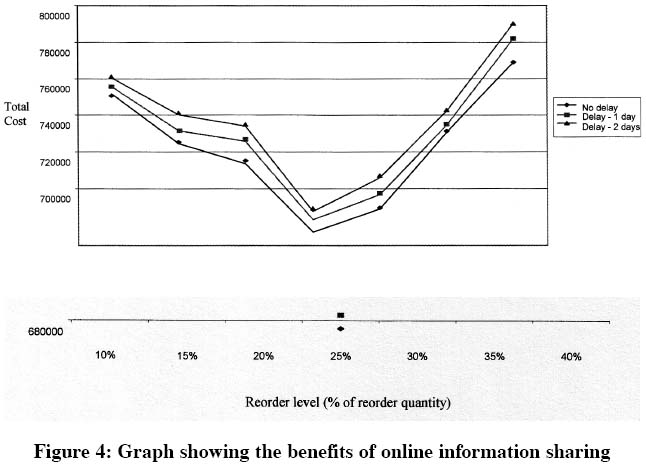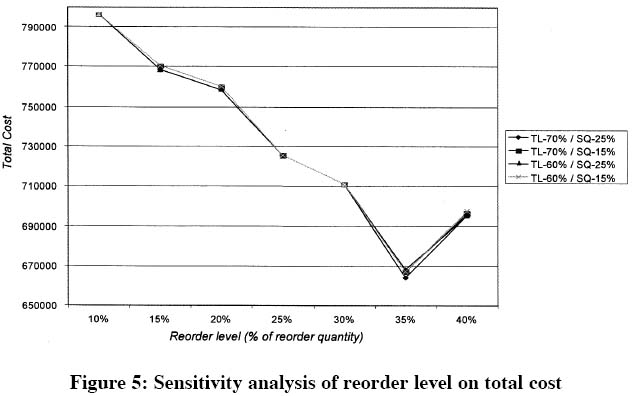Evaluating Lateral Transshipment Policy in a Two-Echelon Inventory System
Kumar Satyendra
Functional Architect, Manugistics India Software Systems Ltd., India
Rao V. Venkata
Indian Institute of Management, Ahmedabad, India
Abstract
Emergency shipments from higher and/or same echelon levels are one of the popular tools to handle the stock-out position at some warehouse. Our paper deals with a lateral stock transshipment model involving one plant and two warehouses, lateral transshipment is considered as an option at each re-order decision under the standard (r,Q) inventory replenishment policy. We focus on incorporating the above stock transfer feature in the order fulfillment decision and designed an simulation to find the effect of lateral stock transfer policy on various parameters viz. average inventory at each warehouse, average number of stock-out days at each warehouse, total cost (comprising of inventory cost, stock-out cost and transportation cost). The experimental results show that the stock transfer policy has the potential to reduce the total cost, average inventory and average stock-out days. We have also compared the cases where information is shared online or with some delay. The delay is because of serial communication between the supply chain players. The results show that there are benefits of no information delay i.e. online information sharing over the case with information delay.Introduction
1 One of the key issues in multiple retailer inventory system, where each retailer is facing random demand, is to handle the stock-out position at one retailer when there is inventory at other retailer. This situation can be resolved either by emergency order to the higher echelon or lateral transshipment from other retailer having inventory to spare. Companies are utilizing emergency lateral transshipments between retailers to meet customer demand to improve service levels and / or reduce costs [Minner et al. (2003)]. The savings in the expected lost sales and inventory costs at the retailers may balance the excess cost of lateral transshipment [Robinson (1990)]. The other issue of lateral transshipment is to figure out the factors influencing the lateral transshipment and its impact on system performance [Evers (2001)]. Recently, Hong-Minh et al. (2000) compared emergency lateral transshipment policy with different strategies for improving customer service. The strategies considers are: EPOS (marketplace information is shared between supply chain players), Excel (stock levels in all locations are centrally controlled), emergency transshipments (transportation route bypassing an echelon), and eliminate (an echelon is removed from the supply chain). They evaluated the strategies by simulation exercise and found that emergency transshipments has a strong impact on customer service level and eliminate results in less stock for an improved customer service level.
2 The common point in all the earlier studies including Das (1975), Lee (1987), Axsater (2003), etc. is that the lateral transshipment is allowed only in case of stock-out situations, i.e. during emergencies. Some of the selected research studies dealing with lateral transshipment are presented in table 1. In the present study, we try to analyze a continuous-review inventory system, which allows lateral transshipments as a regular inventory policy. Our study dealt with the following questions: under what conditions is it advisable for a warehouse to transfer the stock to another warehouse, when both warehouses originally get their orders replenished only from the central plant and how the different parameters will affect the system performance. We confine our study to one plant and two warehouse system, and focus on incorporating the above stock transfer feature in the order fulfillment decision, when both warehouses follow an (r, Q) inventory policy.
Methodology
3 This research is motivated by a multi-product manufacturing company, which has three manufacturing units located in the western region of India and the regional warehouses are located all over the country. The company deals with a variety of products and they often face stock-out situation even at manufacturing units because of large number of product groups and high demand variability. The facilities (corporate office / manufacturing complexes / regional offices) are interconnected by an integrated system for online information sharing. The concerned business groups of corporate office mainly do the production and distribution planning for various products. The shipment to the regional warehouses is done in full truckloads, each truck containing only a single product. However, smaller trucks are used for lateral shipments.
Table 1: Topology of lateral transshipment research
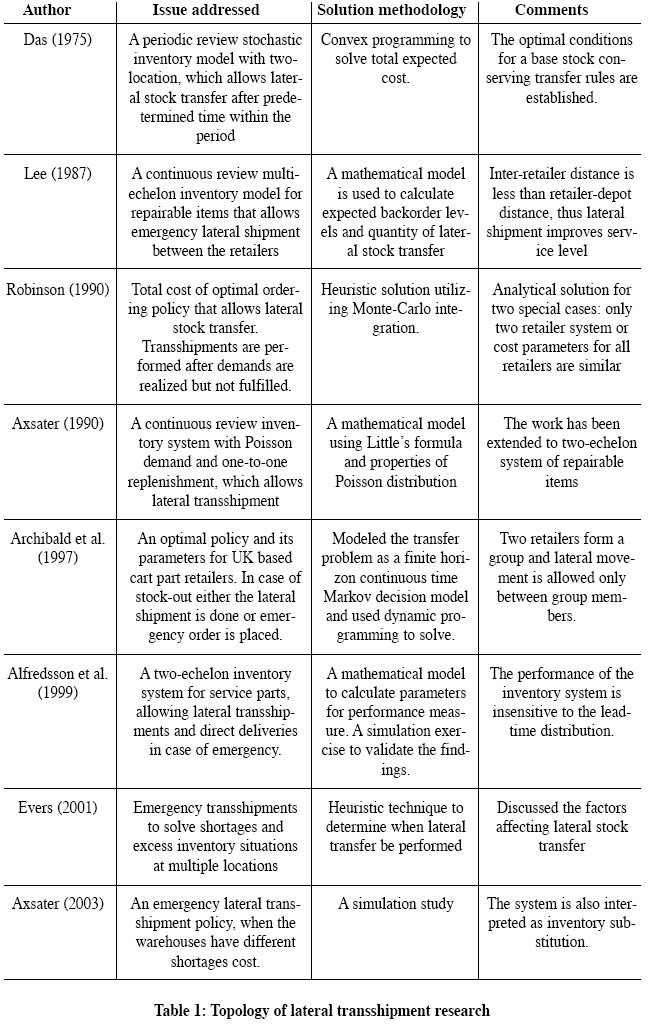
Display large image of Table 1
4 Based on above salient points, we have designed a simulation model to assess the impact of stock transfer within same echelon on transportation, inventory, and stock-out costs and the service level. We have considered a single manufacturing unit and two regional warehouses, which are relatively close to each other compared to the manufacturing unit. We have considered a single product and generated the daily demand (normally distributed) for the two regional warehouses. Each warehouse for stock replenishment follows (r, Q) policy, where ‘ r' is the reorder level and ‘ Q' is the replenishment quantity. The demand experienced by a regional warehouse is fulfilled from its existing stock. In the absence of the stock, orders received by a regional warehouse are lost and stock-out cost is incurred. When the on hand inventory quantity at a warehouse reaches its reorder point, a replenishment order is placed as per the following two cases:
5 Case 1: A stock replenishment order by a warehouse is placed on the manufacturing unit. The order is fulfilled immediately if the plant warehouse has stock on hand; otherwise, the order waits until the product is produced. Case 2: When the on-hand inventory quantity at a warehouse reaches its reorder point, the stock level at other regional warehouse is checked. If the stock level of other warehouse is more than a predetermined threshold level (the stock level above which the stock can be transferred from one warehouse to another warehouse), the order is placed on to the other warehouse. The predetermined quantity is dispatched immediately. In the absence of excess stock at the other warehouse, the order is placed on to the manufacturing unit. The order is dispatched immediately if there is available stock at plant premises otherwise the order waits till the production occurs. The conceptual model is presented in figure 1. The difference between the two cases is the stock transfer linkage between the two warehouses.
Figure 1: Conceptual model
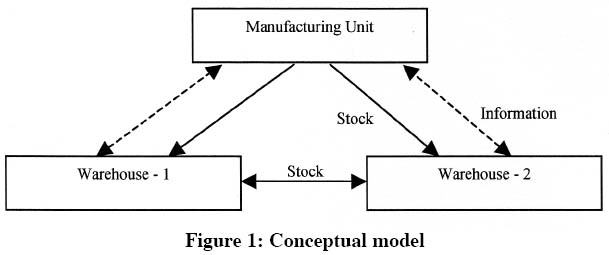
Display large image of Figure 1
Figure 2: Conceptual model

Display large image of Figure 2
Simulation Design
6 We have designed a simulation to find the effect of lateral stock transfer policy on various parameters viz. average inventory at each warehouse, average number of stock-out days at each warehouse, total cost (comprising of inventory cost, stock-out cost and transportation cost). The number of days in each simulation run is 300 and the daily demand is generated for each warehouse. We have first checked the robustness of the simulation design. We have taken each output parameter separately and observed the mean value after each simulation run. We observed that the coefficient of variation of the output value falls below 0.1 after 12-15 runs. In addition, after 20 run the mean of the output value almost stabilizes. Based on these observations, we conducted our experiment with each run consisting of 300 days, the total number of runs being 25 for each experiment.
Experiments and Results
7 We have designed and performed various experiments to analyze the impact of lateral stock transfer policy. In a typical experiment, we have considered:
- Time period as 300 days. The demand for each warehouse is generated for this time period.
- The unit of the product is 20 KG, which costs approximately Rs. 1000.
- The plant production period is bimonthly and the maximum production level is 4000 units.
- The under-stocking cost can be considered as the loss of contribution and will be approximately Rs. 50.
- The overstocking cost includes the inventory holding cost, pilferage cost and other warehouse costs and will be approximately Rs 1 per unit per day.
- The vehicle used to carry material from the manufacturing unit to the regional warehouse has a capacity of 20 MT i.e. 1000 units. Thus, the replenishment quantity ‘ Q' is 1000 units.
- The lateral transshipment is performed by small canters having capacity of 4 / 5 MT, which is equivalent to 200 / 250 units of product. Thus, the lateral shipment quantity is 200 / 250 units.
8 The predetermined threshold level and reorder level are considered to percentage of replenishment quantity ‘ Q'. Thus, the transfer 70% means that the lateral transfer will happen only when the stock at the warehouse is more than 70% of replenishment quantity ‘ Q' i.e. 700 units. Similarly, 20% reorder level means reorder level is 20% of replenishment quantity ‘ Q' i.e. 200 units.
9 We have generated various test problems by varying the transportation cost, transit time and demand distribution parameters. For each test problem, we have varied the reorder level and threshold stock level and run 25 instances. For each instance, we have recorded various outputs viz. total cost, average inventory and average number of stock-out days. Some of these results have been plotted to discuss the trends.
10 We have also performed experiments to analyze the situation when the lateral shipment from only warehouse rather than from both warehouses. We have assumed the transit time of the two warehouses from the manufacturing unit to be 8 and 10 days. The warehouse with transit time of 8 days can only transfer the stock to other warehouse.
Figure 3: Graphs showing the results
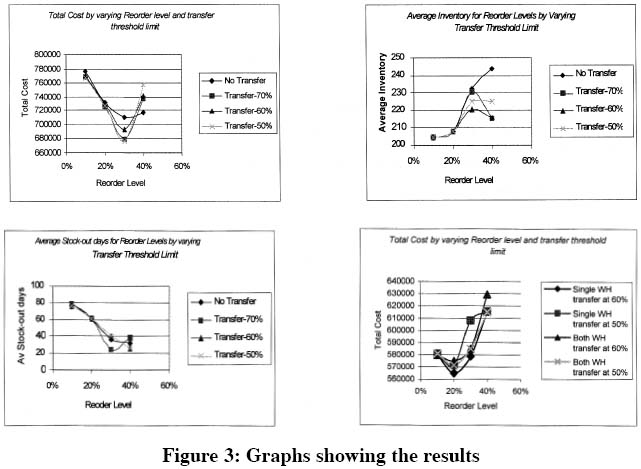
Display large image of Figure 3
- The curves show that the average stock-out days in case of stock transfer are less than no stock transfer case for almost all reorder levels.
- In case of no transfer, the average stock-out days shows the downward trend with increasing reorder level, which is obvious. But, in case of stock transfer, the average stock-out days first decreases and then increases with increasing reorder level. It is because at high reorder level, the lateral transshipments are frequent and thus the other warehouse faces stock-out conditions.
- At high reorder level [40%], the no stock transfer policy seems to be better than the stock transfer policy as the warehouses keeps enough safety stocks to deal with uncertainty and the lateral transshipment only adds to the transportation cost. Moreover, the objective of stock transfer policy to enhance the service level even by maintaining lower stock level is not met at higher reorder levels.
- For some parameter values, the stock transfer from single warehouse is beneficial than that of both warehouses performing lateral transshipment.
Benefit of Information Sharing
11 We have also compared the cases where there is no information delay and information delay of 1 and 2 days. The delay is because of serial communication once the reorder level is reached at one warehouse. The results show that the benefit of no information delay i.e. online information sharing over cases with information delay of 1 day is approximately 2%.
Figure 4: Graph showing the benefits of online information sharing
Sensitivity Analysis
12 The performance of the stock transfer policy depends mainly on three parameters i.e. re-order level, threshold level, and lateral shipment quantity. We have designed experiments to find the sensitivity of these three parameters. We have varied reorder level, threshold level and lateral shipment quantity, and computed the total cost for various input combinations. From the results, we have figured out that the reorder level is the most sensitive parameter. In addition, at every reorder level, the combination of threshold level and lateral shipment quantity also plays a very important role in overall policy performance.
Figure 5: Sensitivity analysis of reorder level on total cost
Inferences
13 From the representative results, we have the following inferences:
- The stock transfer policy has the potential to reduce the total cost, average inventory and average stock-out days by approximately 4-5%.
- The result shows that the benefit of no information delay i.e. online information sharing over the case with information delay is approximately 2%.
- The stock transfer policy can maintain a similar service level and reduces the total cost at lower inventory level i.e. reorder level.
- There were situations where stock transfer from only one warehouse is beneficial instead of stock transfer from both the warehouses.
- The managerial implications of this simulation model are as follows:
- The simulation model solves for various reorder level and stock transfer level to identify the best inventory policy for a given set of parameters.
- From the sensitivity analysis, one can figure out the parameter with maximum variations.
- The impact of various parameters can also be analyzed and based on the criticality it can be taken care.
- Based on the experiments, the inventory policy can be analyzed and implemented.
Conclusion
14 The idea of warehouses directly replenishing one another has potential to reduce costs in inventory management .The existing literature has analyzed the lateral stock transfer policy in two major cases viz. emergency transshipment and after fixed time-period. The present study is different in that it is not concerned with emergency transshipments, but with considering lateral stock transfer at every re-ordering event. Our model shows that the stock transfer policy has the potential to reduce the total cost, average inventory and average stock-out days by approximately 4-5%. The results obviously are limited to the values of the parameters used in the experiments. Further research can be undertaken to extend the ideas of this paper in two different directions: 1) An understanding of the general relationship between the optimal value of the objective function and the parameters of interest, 2) Analysis of a system consisting of several plants and several warehouses.
References
Alfredsson, P., and Jos V., "Modeling emergency supply flexibility in a two-echelon inventory system,” Management Science, Volume 46, Issue 10, pp. 1416-1431, 1999.
Archibald, T. W., Sassen S. A. E., and Thomas L. C., "An optimal policy for a two depot inventory problem with stock transfer,” Management Science, Volume 43, Issue 2, pp. 173-183, 1997.
Axsater, S., "Modeling emergency lateral transshipments in inventory systems,” Management Science, Volume 36, Issue 11, pp. 1329-1338, 1990.
Axsater, S., "Evaluation of unidirectional lateral transshipments and substitutions in inventory systems,” European Journal of Operational Research, Volume 149, Issue 2, pp. 438-447, 2003.
Das, C., "Supply and redistribution rules for two-location inventory systems: One-period analysis,” Management Science, Volume 21, Issue 7, pp. 765-776, 1975.
Evers, P. T., "Heuristics for assessing emergency transshipments,” European Journal of Operational Research, Volume 129, Issue 2, pp. 311-316, 2001.
Hong-Minh, S. M., Disney S. M., and Naim M. M., "The dynamics of emergency transshipment supply chains,” International Journal of Physical Distribution and Logistics Management, Volume 30, Issue 9, pp. 788-816, 2000.
Lee, H. L., "A multi-echelon inventory model for repairable items with emergency lateral transshipments,” Management Science, Volume 33, Issue 10, pp. 1302-1316, 1987.
Minner, S., Silver E. A., and Robb D. J., "An improved heuristic for deciding on emergency transshipments,” European Journal of Operational Research, Volume 148, Issue 2, pp. 384-400, 2003.
Robinson, L. W., "Optimal and approximate policies in multiperiod, multiloca-tion inventory models with transshipments,” Operations Research, Volume 38, Issue 2, pp. 278-295, 1990.
